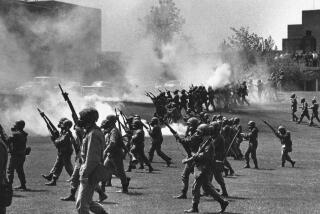Look Beneath the Surface of School Violence
- Share via
A 6-year-old boy does the unthinkable, and within hours we learn of the depraved conditions in which he lived: He came from a dysfunctional family with a drug-addicted mother and a father in jail. At the time of the shooting, he was living with his uncle in a rundown home suspected of being a crack house.
Again, we’re reminded of how strongly our surroundings affect us all. Again, we’re hearing the chorus of calls for gun control and the installation of metal detectors in schools.
Although the circumstances were very different, beginning with the young age of the Michigan boy, the tragedy reminds us of Littleton, Colo., West Paducah, Ky., and Conyers, Ga. We, as parents and grandparents, understandably crave actions that will fix whatever is dangerously broken in our schools. Why is it that we can so clearly see the importance of the context of the young Michigan boy’s life, yet we’re reluctant to look at the underlying atmosphere of the schools in which the other shootings occurred?
Tighter gun control laws are fine. In some schools, metal detectors may be useful. But let’s also focus attention on the undercurrent of anger, bullying and taunting that is prevalent in most American schools. Let’s not rush in with half-baked interventions like posting the Ten Commandments in classrooms when richer options are available.
Social psychologists have compiled an impressive library of data over the past 40 years that tells a lot about why humans behave the way we do. Our work is concerned with important aspects of human social behavior, including persuasion, conformity, love, hate, aggression and prejudice. For years, those with a financial incentive, like politicians and advertisers, have been able to ferret out useful findings that help them get elected and sell cigarettes, but we as scientists have done a poor job of getting our social-psychological findings where they can be useful. It’s time to change that.
Clearly, the tragedies that unfolded in Littleton, West Paducah and elsewhere were pathological, violent acts. The perpetrators of these horrifying deeds were disturbed. Yet if we chalk up these events simply to individual pathology, we are missing something of vital importance. These perpetrators were reacting in an extreme and pathological manner to a general school atmosphere that breeds an environment of exclusion, mockery and taunting.
If we can change the social atmosphere of the classroom, we might succeed in making schools safer places and also in producing the kind of social environment that will make schools a more pleasant, stimulating, compassionate and humane place for all students. By creating an atmosphere in which there are no “losers,” we can help students learn important human values as they learn arithmetic, reading and science.
Easier said than done, you say? Not necessarily. For the past 30 years, social psychologists have been conducting scientific experiments in classrooms at hundreds of schools on a cooperative learning structure called “the jigsaw classroom.” This strategy involves placing students in small groups and giving each student a piece of information--a part of the puzzle--all of which is necessary for the team’s successful completion of the lesson. Students thus are motivated to listen respectfully to one another, to help one another and to begin to care about one another. Students who have been prejudiced against each other because of racial or ethnic differences--or simply because they looked or acted differently--have actually become close friends.
Best of all, they learn all this while in the process of learning all the traditional academic subjects as well or better than they would in more traditional classrooms. The strategy doesn’t require any new curricular material; it simply involves teaching traditional material in a nontraditional structure in which children pull together rather than compete against one another.
Unfortunately, it takes a tragedy to arouse the public’s interest in changing the atmosphere in our schools and to motivate social psychologists to make our research more accessible to people who can use it. Knowledge is power, and parents, teachers and ordinary citizens need to know that there are proven, effective classroom interventions that can reduce their feelings of helplessness and empower them to take action to make their children’s school safer and more humane.
If we cannot succeed in teaching our children to be more compassionate, more caring and more empathetic of one another, gun control and metal detectors will never make them safe.
More to Read
Sign up for Essential California
The most important California stories and recommendations in your inbox every morning.
You may occasionally receive promotional content from the Los Angeles Times.













